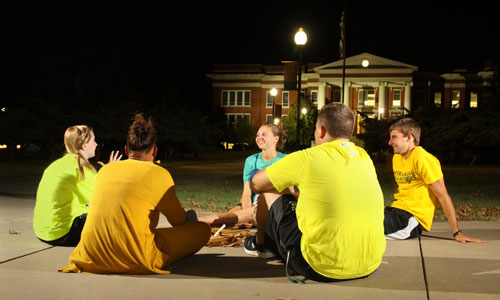OBU Ranks as 'A-Plus School' by U.S.News & World Report
September 12, 2012
OBU has been ranked as the only Oklahoma college or university on U.S.News & World Report's annual ranking of "A-Plus Schools for B Students" for Regional Colleges for 2013. OBU also has been listed as Oklahoma's highest-ranked college in "Best Regional Colleges" for the 19th consecutive year and was one of only two Oklahoma colleges on the "Great Schools at Great Prices" list for Regional Colleges in the West.
OBU has made the news magazine's "top 10" in its category for 21 consecutive years. The exclusive rankings, which include more than 1,400 schools nationwide, are available here today, Sept. 12. They also will be published in the 332-page 2013 edition of the Best Colleges guidebook, available here and on newsstands Sept. 18.

OBU students meet during Welcome Week on Monday, Aug. 20, near Shawnee Hall.
"OBU continues to build a vision for our future on the long-standing excellence that has garnered attention from rankings such as U.S.News & World Report for more than two decades," said OBU President David W. Whitlock. "These rankings represent the ongoing faithfulness of OBU's faculty, staff and students to the University's mission, which reflects our commitment to the highest quality in a Christian liberal arts education."
The "A-Plus Schools for B Students" rankings include colleges and universities which consider good students with less-than-stellar test scores or so-so grade point averages for admission. The rankings are based on variables: the school's performance in the U.S.News & World Report's "2012 Best Colleges" rankings and the average freshman retention rate. Therefore, the list includes exceptional colleges and universities which provide resources for academically average students to achieve success.
Over the past two decades, the U.S. News college rankings, which group schools based on the Carnegie Classification of Institutions of Higher Education, has grown to be the most comprehensive research tool for students and parents considering higher education opportunities.
"These rankings affirm OBU's commitment to academic excellence for all students," said Dr. Stan Norman, provost and executive vice president for campus life. "OBU's mission is to transform students' lives, and these rankings affirm success in that mission on Bison Hill. We celebrate the hard work and commitments that make such achievements possible."
The calculation for "Great Schools at Great Prices" takes into account a school's academic quality, based on its U.S. News "Best Colleges" 2013 ranking, and the 2011-12 net cost of attendance for a student who receives the average level of need-based financial aid. The higher the quality of the program and the lower the cost, the better the deal.
"Once again our position in the national rankings underscores the high academic quality and affordability of an OBU education," said Bruce Perkins, dean of enrollment management at OBU. "OBU is committed to investing heavily in our students. More than $16 million in scholarships was awarded this past academic year. Students who are serious about their studies and who desire to integrate their faith with academics need to consider OBU as the premier option within the state when selecting a university."
According to information provided by U.S. News, the rankings system rests on two pillars. It relies on quantitative measures which education experts have proposed as reliable indicators of academic quality, and on the magazine's nonpartisan view of "what matters in education." First, schools are categorized by mission. U.S. News then gathers data from each college for up to 16 indicators of academic excellence. Each factor is assigned a weight that reflects the magazine's judgment about how much a measure matters. Finally, the colleges in each category are ranked against their peers, based on their composite weighted score. A more detailed explanation is available on the U.S. News website here.
To sort colleges and universities into their appropriate ranking categories, U.S. News used the Carnegie Foundation for the Advancement of Teaching's recently announced changes to its highly respected Basic Classification. The 2010 update was the first major category revision by Carnegie since 2006. As a result, many colleges switched ranking categories and some schools were added to the rankings for the first time. The category changes were the main explanation for the biggest movements in the 2011-12 rankings. U.S. News included in the rankings all for-profit colleges and universities that grant bachelor's degrees and are regionally accredited. These include many schools that have large online bachelor's degree programs.